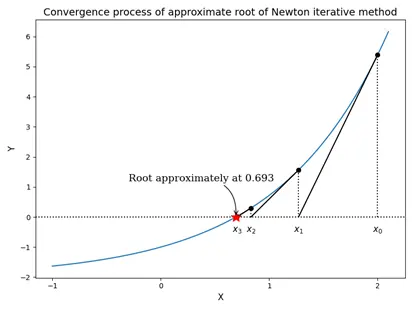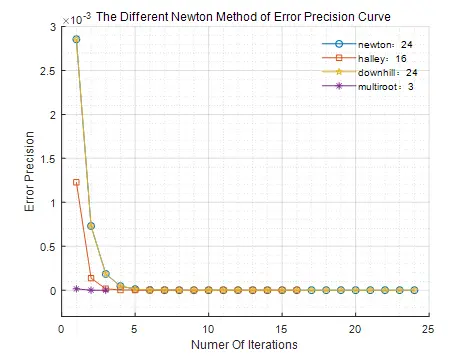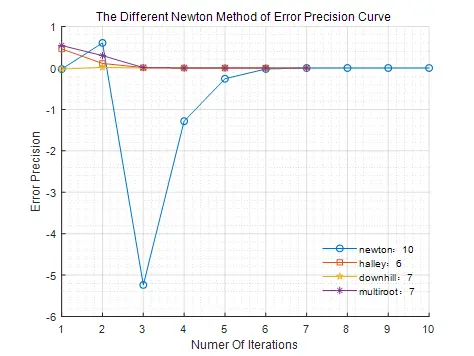1 牛顿迭代法
牛顿迭代法实质上是一种线性化方法,其基本思想是将非线性方程逐步归结为某种线性方程来求解。
1.1 牛顿法
牛顿迭代法又称切线法,是一种有特色的求根方法。用牛顿迭代法求的单根
的主要步骤:
(1)Newton法的迭代公式
(2)以附近的某一个值
为迭代初值,代入迭代公式,反复迭代,得到序列
(3)若序列收敛,则必收敛于精确根,即
。
牛顿法有显然的几何意义,方程的根
可解释为曲线与轴交点的横坐标。设
是根
的某个近似值,过曲线
上横坐标为
的点
引切线,并将该切线与
轴交点的横坐标
作为
的新的近似值。
牛顿法初值的选择:若在
上连续,存在2阶导数,且满足下列条件:
(1);
(2)在
内不变号,且
;
(3)在
内不变号,且
;
(4),且
;
则对任意的初值,牛顿迭代序列收敛于
在
内的唯一根。
牛顿的优缺点:牛顿法是目前求解非线性方程(组)的主要方法,至少二阶局部收敛,收敛速度较快,特别是当迭代初值充分靠近精确解时。对重根收敛速度较慢(线性收敛),对初值的选取很敏感,要求初值相当接近真解,需要求导数。

图1 牛顿法迭代收敛过程的几何意义
1.2 哈利牛顿法
哈利法(Halley)可用于加速牛顿法收敛,哈利迭代公式:
哈利法在单根情况下可达到三阶收敛。
1.3 简化牛顿法
将牛顿法的迭代公式改为
为保证收敛,系数只需满足
即可。如果
取常数
,则称为简化牛顿法,也称平行弦法。
简化牛顿法线性收敛。
1.4 牛顿下山法
牛顿法的收敛性依赖初值的选取,如果
偏离所求根
较远,则牛顿法可能发散。牛顿下山法,引入下山因子
,保证函数值稳定下降的同时,加速收敛速度。
牛顿下山法公式:
下山因子的取法:从开始,逐次减半,即
,直到满足下降条件。
1.5 重根情形
当为
的
重根时,则
可表为
,其中
,此时用牛顿迭代法求
仍然收敛,只是收敛速度将大大减慢,牛顿法求方程的重根时仅为线性收敛。
将求重根问题化为求单根问题进行牛顿法求解。对,令函数
则化为求的单根
的问题,对它用牛顿法是二阶收敛的。其迭代函数为
从而构造出迭代方法
2 牛顿迭代法MATLAB算法实现
算法说明:
(1)输入参数的判定和必要的处理,包括可变参数的处理,若某个可变参数不输入,则采用默认值。
(2)由于牛顿法需要计算方程的一阶导数和二阶导数(重根情形),故方程的定义采用符号定义(避免手工计算方程的导数所带来的计算量),在算法solve_diff_fun(equ)中实现符号函数的一阶导数和二阶导数的计算,并转换为匿名函数进行数值运算。
(3)根据参数method选择执行不同的牛顿迭代方法,具体:
1)“newton”为牛顿法newton();
2)“simplify”为简化的牛顿法simplify_newton();
3)“halley”为哈利法(牛顿加速法)newton_halley();
4)“downhill”为牛顿下山法newton_downhill(),下山法包括了下山因子的存储;
5)“multi”为重根情形newton_multi_root()。
(4)根据参数display选择是否显示迭代过程信息或仅显示结果信息。
(5)可变输出参数的判定和必要处理。
思考:MATLAB中没有类似于Python的list结构,如何在未知迭代次数的情况下,预分配内存,存储迭代过程变量信息?
function varargout = newton_root(equ_func, x0, varargin)
%% 牛顿法求解方程的根,包含简化牛顿法 simplify ,牛顿法 newton ,牛顿加速哈利法 halley ,牛顿下山法 downhill 和重根情形 multi_r 。
% 1. equ_func表示待求(非)线性方程,要求是符号函数定义
% 2. x0表示迭代求解的初值
% 3. varargin 表示可变参数
% 4. 输出参数varargout为可变参数:
% 4.1 如果输出参数为3个,则第1个参数为近似解,第2个参数为近似解的精度误差,第3个参数为退出条件
% 4.2 如果输出参数为2个,则第1个参数为近似解,第2个参数为近似解的精度误差
% 4.3 如果输出参数为1个,则表示牛顿法求解的结构体,包括各种迭代过程中的信息
%% 1.输入参数的判别与处理
if nargin < 2
error("输入参数不足,请输入完整参数equ_func和x0....")
end
if class(equ_func) ~= "sym"
error("缺失参数 equ_func 或参数 equ_func 定义错误...")
end
if class(x0) ~= "double"
error("缺失参数 x0 或参数 x0 定义错误...")
end
args = inputParser; % 函数的输入解析器
addParameter(args, 'method', "newton"); % 设置牛顿法的求解形式,默认值普通newton法
addParameter(args, 'eps', 1e-10); % 设置求解精度参数eps,默认值1e-10
addParameter(args, 'display', 'final'); % 设置是否显示迭代过程参数display,默认值final,可为iter
addParameter(args, 'max_iter', 200); % 设置最大迭代次数参数max_iter,默认值200
parse(args,varargin{:}); % 对输入变量进行解析,如果检测到前面的变量被赋值,则更新变量取值
method = args.Results.method; % 求解方法
global eps % 精度,定义为全局变量
eps = args.Results.eps; % 若未传参,精度获取默认值
display = args.Results.display; % 是否显示迭代过程
global max_iter % 最大迭代次数,全局变量
max_iter = int16(args.Results.max_iter); % 若未传参,最大迭代次数获取默认值
%% 2. 计算f(x)的一阶导和二阶导函数,并转换为匿名函数
[fx, dfx, d2fx] = solve_diff_fun(equ_func);
%% 3. 根据所采用的求解方法method选择对应的牛顿法形式求解
if lower(method) == "newton"
method_message = "普通牛顿迭代法";
iter_info = newton(fx, dfx, x0); % 普通牛顿法
elseif lower(method) == "halley"
method_message = "牛顿—哈利迭代法";
iter_info = newton_halley(fx, dfx, d2fx, x0); % 牛顿—哈利法
elseif lower(method) == "simplify"
method_message = "简化的牛顿迭代法";
iter_info = simplify_newton(fx, dfx, x0); % 简化牛顿法
elseif lower(method) == "downhill"
method_message = "牛顿下山迭代法";
[iter_info, downhill_lambda] = newton_downhill(fx, dfx, x0); % 牛顿下山法
elseif lower(method) == "multi_r"
method_message = "牛顿重根情形迭代法";
iter_info = newton_multi_root(fx, dfx, d2fx, x0); % 牛顿重根情形
else
warning("牛顿法仅限于【newton、halley、simple、downhill和multi_r】之一,此处采用牛顿法求解!")
method_message = "普通牛顿迭代法";
iter_info = newton(fx, dfx, x0); % 普通牛顿法
end
%% 4. 根据参数display,显示迭代过程或迭代结果信息
if lower(display) == "iter"
disp(method_message)
disp(array2table(iter_info, 'VariableNames', ["IterNums", "ApproximateSol", "ErrorPrecision"]))
elseif lower(display) == "final"
fprintf(method_message + ":IterNum = %d, ApproximateSolution = %.15f, ErrorPrecision = %.15e\n", ...
iter_info(end, 1), iter_info(end, 2), iter_info(end, 3));
else
warning("参数display仅限于【iter、final】之一!")
end
%% 2. 1求符号方程的一阶导和二阶导,并转换为匿名函数,方便计算
function [equ_expr, diff_equ, diff2_equ] = solve_diff_fun(equ)
x = symvar(equ); % 获取符号函数的变量
diff_equ = matlabFunction(diff(equ, x, 1)); % 一阶导数方程,并转换为匿名函数
diff2_equ = matlabFunction(diff(equ, x, 2)); % 二阶导数方程,并转换为匿名函数
equ_expr = matlabFunction(equ); % 原符号方程转换为匿名函数
end
%% 3. 1 牛顿法求解
function iter_info = newton(fx, dfx, x0)
var_iter = 0; % 迭代次数变量
sol_tol = fx(x0); % 方程在当前迭代值的精度,初始为初值时的精度
if abs(sol_tol) < eps
iter_info = [1, x0, sol_tol];
return
end
x_cur = x0; % 迭代过程中的对应于x_(k)
iter_info =zeros(max_iter, 3); % 存储迭代过程信息,思考如何预分配内存?
% 算法具体迭代多少次,不清楚,故用while。可用for循环,在循环体内,满足精度要求退出循环
while abs(sol_tol) > eps && var_iter < max_iter
var_iter = var_iter + 1; % 迭代次数增一
x_next = x_cur - fx(x_cur) / dfx(x_cur); % 牛顿迭代公式
sol_tol = fx(x_next); % 新值的精度
x_cur = x_next; % 近似根的迭代更替
iter_info(var_iter, :) = [var_iter, x_next, sol_tol];
end
if var_iter < max_iter
iter_info(var_iter + 1:end, :) = []; % 删除未赋值的区域
end
end
%% 3. 2 牛顿—哈利法法求解
function iter_info = newton_halley(fx, dfx, d2fx, x0)
var_iter = 0; % 迭代次数变量
sol_tol = fx(x0); % 方程在当前迭代值的精度,初始为初值时的精度
if abs(sol_tol) < eps
iter_info = [1, x0, sol_tol];
return
end
x_cur = x0; % 迭代过程中的对应于x_(k)
iter_info =zeros(max_iter, 3); % 存储迭代过程信息
while abs(sol_tol) > eps && var_iter < max_iter
var_iter = var_iter + 1; % 迭代次数增一
fval = fx(x_cur); % 当前近似解的方程精度
df_val = dfx(x_cur); % 当前近似解的方程一阶导数精度
d2f_val = d2fx(x_cur); % 当前近似解的方程二阶导数精度
x_next = x_cur - fval / df_val / (1 - fval * d2f_val / (2* df_val^2)); % 牛顿哈利迭代公式
sol_tol = fx(x_next); % 新值的精度
x_cur = x_next; % 近似根的迭代更替
iter_info(var_iter, :) = [var_iter, x_next, sol_tol];
end
if var_iter < max_iter
iter_info(var_iter + 1:end, :) = []; % 删除未赋值的区域
end
end
%% 3. 3 简化牛顿法求解
function iter_info = simplify_newton(fx, dfx, x0)
var_iter = 0; % 迭代次数变量
lambda = 1 / dfx(x0); % 简化牛顿法的常数
sol_tol = fx(x0); % 方程在当前迭代值的精度,初始为初值时的精度
if abs(sol_tol) < eps
iter_info = [1, x0, sol_tol];
return
end
x_cur = x0; % 迭代过程中的对应于x_(k)
iter_info =zeros(max_iter, 3); % 存储迭代过程信息,思考如何预分配内存?
while abs(sol_tol) > eps && var_iter < max_iter
var_iter = var_iter + 1; % 迭代次数增一
x_next = x_cur - lambda * fx(x_cur); % 简化牛顿迭代公式
sol_tol = fx(x_next); % 新值的精度
x_cur = x_next; % 近似根的迭代更替
iter_info(var_iter, :) = [var_iter, x_next, sol_tol];
end
if var_iter < max_iter
iter_info(var_iter + 1:end, :) = []; % 删除未赋值的区域
end
end
%% 3. 4 牛顿下山法求解
function [iter_info, downhill_lambda] = newton_downhill(fx, dfx, x0)
var_iter = 0; % 迭代次数变量
sol_tol = fx(x0); % 方程在当前迭代值的精度,初始为初值时的精度
if abs(sol_tol) < eps
iter_info = [1, x0, sol_tol];
downhill_lambda = [1];
return
end
x_cur = x0; % 迭代过程中的对应于x_(k)
iter_info =zeros(max_iter, 3); % 存储迭代过程信息,思考如何预分配内存?
downhill_lambda = ones(max_iter); % 存储下山因子
while abs(sol_tol) > eps && var_iter < max_iter
var_iter = var_iter + 1; % 迭代次数增一
f_val = fx(x_cur); % 当前近似解的方程精度
df_val = dfx(x_cur); % 当前近似解的方程一阶导数精度
x_next = x_cur - f_val / df_val; % 牛顿迭代公式
sol_tol = fx(x_next); % 新值的精度
% 判别是否满足下降条件
while abs(sol_tol) > abs(f_val)
downhill_lambda(var_iter) = downhill_lambda(var_iter) / 2; % 下山因子减半
x_next = x_cur - downhill_lambda(var_iter) * f_val / df_val; % 牛顿下山迭代公式
sol_tol = fx(x_next); % 新值的精度
end
x_cur = x_next; % 近似根的迭代更替
iter_info(var_iter, :) = [var_iter, x_next, sol_tol];
end
if var_iter < max_iter
iter_info(var_iter + 1:end, :) = []; % 删除未赋值的区域
downhill_lambda(var_iter + 1:end) = []; % 删除未赋值的区域
end
end
%% 3. 5 牛顿法重根情形求解
function iter_info = newton_multi_root(fx, dfx,d2fx, x0)
var_iter = 0; % 迭代次数变量
sol_tol = fx(x0); % 方程在当前迭代值的精度,初始为初值时的精度
if abs(sol_tol) < eps
iter_info = [1, x0, sol_tol];
return
end
x_cur = x0; % 迭代过程中的对应于x_(k)
iter_info =zeros(max_iter, 3); % 存储迭代过程信息,思考如何预分配内存?
while abs(sol_tol) > eps && var_iter < max_iter
var_iter = var_iter + 1; % 迭代次数增一
fval = fx(x_cur); % 当前近似解的方程精度
df_val = dfx(x_cur); % 当前近似解的方程一阶导数精度
d2f_val = d2fx(x_cur); % 当前近似解的方程二阶导数精度
x_next = x_cur -fval * df_val / (df_val^2 - fval * d2f_val); % 牛顿重根情形迭代公式
sol_tol = fx(x_next); % 新值的精度
x_cur = x_next; % 近似根的迭代更替
iter_info(var_iter, :) = [var_iter, x_next, sol_tol];
end
if var_iter < max_iter
iter_info(var_iter + 1:end, :) = []; % 删除未赋值的区域
end
end
%% 5. 输出参数结构体的构造
sol.ApproximateSolution = iter_info(end, 2); % 数值近似解
sol.ErrorPrecision =iter_info(end, 3); % 数值近似解误差
sol.NumerOfIterations = iter_info(end, 1); % 迭代次数
sol.NewtonMethod = method; % 所采用的方法
sol.IntrationProcessInfomation = iter_info; % 迭代过程信息
if length(iter_info) == max_iter
sol.info = "已达最大迭代次数";
end
if length(iter_info) < max_iter
sol.convergence = "收敛到满足精度的近似解";
else
sol.convergence = "精度过高,或未收敛到满足精度的解,增大迭代次数或修改初值或降低精度要求";
end
if lower(method) == "downhill"
sol.DownhillLambda = downhill_lambda;
end
%% 6. 输出参数的判别
if nargout == 3
varargout{1} = iter_info(end, 2);
varargout{2} = iter_info(end, 3);
if length(iter_info) == max_iter
varargout{3} = 0; % 退出标记
else
varargout{3} = 1; % 退出标记
end
elseif nargout == 2
varargout{1} = iter_info(end, 2);
varargout{2} = iter_info(end, 3);
elseif nargout == 1
varargout{1} = sol;
elseif nargout == 0
varargout{1} = iter_info(end, 2); % 仅给出近似解
else
error("输出参数最多为3个....")
end
end3 牛顿迭代法案例测试
例1:求非线性方程在区间的近似根
可视化函数图像:
syms x
equ_func = 2 * exp(-x) * sin(x) + 2 * cos(x) - 0.25;
fplot(equ_func, [-3.5, 5], "r-", "LineWidth", 1.5);
hold on
fplot(@(x) x * 0, [-3.5, 5], "k--")
xlabel('$x$','FontSize',12,'Interpreter','latex');
ylabel('$y$','FontSize',12,'Interpreter','latex');
title("$ 2e^{-x}sinx + 2cosx - 0.25=0$", 'FontSize', 14, 'Interpreter','latex')
grid on; grid minor; box off; hold off

图2 非线性方程图像
从图中可以看出,在区间内存在四个根,此处仅求在附近的根,其他根求解自行设计。
验证输入参数:
>> sol_newton = newton_root(equ_func, "display", "iter", "eps", 1e-16, "method", "newton");
错误使用 newton_root (第 21 行)
缺失参数 x0 或参数 x0 定义错误...
>> sol_newton = newton_root(x0, "display", "iter", "eps", 1e-16, "method", "newton");
错误使用 newton_root (第 17 行)
缺失参数 equ_func 或参数 equ_func 定义错误...验证输出参数,仅有一个输出参数,则为结构体,且输出迭代过程:
>> sol_newton = newton_root(equ_func, x0, "display", "iter", "eps", 1e-16, "method", "newton")
普通牛顿迭代法
IterNums ApproximateSol ErrorPrecision
________ __________________ _____________________
1 -0.875 -2.65048857279132
2 -0.555391102428116 -0.388296167451843
3 -0.489056835053933 -0.0167045381738624
4 -0.485935114436592 -3.66522867834007e-05
5 -0.485928234722167 -1.77926784417082e-10
6 -0.48592823468877 0
sol_newton =
包含以下字段的 struct:
ApproximateSolution: -0.485928234688770
ErrorPrecision: 0
NumerOfIterations: 6
NewtonMethod: "newton"
IntrationProcessInfomation: [6×3 double]
convergence: "收敛到满足精度的近似解"验证输出参数,有三个输出参数,分别为近似解、方程在近似解处的误差精度和退出标记,1表示收敛到满足精度要求的近似解,且输出最终迭代结果:
>> [x, f_eps, exitflag, iter] = newton_root(equ_func, x0, "display", "final", "eps", 1e-16, "method", "newton")
普通牛顿迭代法:IterNum = 6, ApproximateSolution = -0.485928234688770, ErrorPrecision = 0.000000000000000e+00
错误使用 newton_root (第 235 行)
输出参数最多为3个....
>> [x, f_eps, exitflag] = newton_root(equ_func, x0, "display", "final", "eps", 1e-16, "method", "newton")
普通牛顿迭代法:IterNum = 6, ApproximateSolution = -0.485928234688770, ErrorPrecision = 0.000000000000000e+00
x =
-0.485928234688770
f_eps =
0
exitflag =
1例2:求带有重根的非线性方程在附近的近似解
由于简化的牛顿法收敛速度较慢,此处不再可视化简化的牛顿法。
syms x
equ_func = (x - 1) * (sin(x - 1) + 3 * x) - x^3 + 1;
x0 = 0.9;
sol_newton = newton_root(equ_func, x0, "display", "iter", "eps", 1e-16, "method", "newton");
sol_halley = newton_root(equ_func, x0, "display", "iter", "eps", 1e-16, "method", "halley");
sol_simplify = newton_root(equ_func, x0, "display", "iter", "eps", 1e-16, "method", "simplify");
sol_downhill = newton_root(equ_func, x0, "display", "iter", "eps", 1e-16, "method", "downhill");
sol_multi_r = newton_root(equ_func, x0, "display", "iter", "eps", 1e-16, "method", "multi_r");
figure
plot(sol_newton.IntrationProcessInfomation(:, 1), sol_newton.IntrationProcessInfomation(:, 3), "o-", "LineWidth", 1)
hold on
plot(sol_halley.IntrationProcessInfomation(:, 1), sol_halley.IntrationProcessInfomation(:, 3), "s-", "LineWidth", 1)
% plot(sol_simplify.IntrationProcessInfomation(:, 1), sol_simplify.IntrationProcessInfomation(:, 3), "p-", "LineWidth", 1)
plot(sol_downhill.IntrationProcessInfomation(:, 1), sol_downhill.IntrationProcessInfomation(:, 3), "p-", "LineWidth", 1)
plot(sol_multi_r.IntrationProcessInfomation(:, 1), sol_multi_r.IntrationProcessInfomation(:, 3), "*-", "LineWidth", 1)
legend("newton:" + string(sol_newton.NumerOfIterations), "halley:" + string(sol_halley.NumerOfIterations), ...
"downhill:" + string(sol_downhill.NumerOfIterations), "multiroot:" + string(sol_multi_r.NumerOfIterations))
legend("boxoff")
grid on; grid minor
box off; hold off
axis([0, 25, -0.0003, 3e-3])
xlabel("Numer Of Iterations")
ylabel("Error Precision")
title("The Different Newton Method of Error Precision Curve")可视化各牛顿法的误差精度下降曲线如图3,可见在存在重根情形下,采用牛顿重根公式,收敛速度极快,其次为牛顿哈利法。由于此处未用到下山因子,故牛顿法和牛顿下山法求解过程一致。

图3 带有重根的牛顿法各迭代方法的精度误差曲线
各方法迭代过程
普通牛顿迭代法
IterNums ApproximateSol ErrorPrecision
________ _________________ ____________________
1 0.947892373805653 0.00285545902358852
2 0.973327008365232 0.000730340585354261
3 0.986493966243405 0.000184871077568705
4 0.993202483991711 4.65199555944595e-05
5 0.996589832769599 1.16688756544026e-05
6 0.998292027147433 2.92215229613646e-06
7 0.999145286557988 7.31159377154178e-07
8 0.999572460931 1.82867799680686e-07
9 0.999786184803889 4.57267127496053e-08
10 0.999893080977268 1.14328996270174e-08
11 0.999946537631102 2.85837764568697e-09
12 0.99997326810061 7.14613479502191e-10
13 0.999986633870396 1.78655867877353e-10
14 0.999993316892757 4.46641612583676e-11
15 0.99999665843075 1.116617909247e-11
16 0.999998329221071 2.79143375081503e-12
17 0.999999164587949 6.97886193279373e-13
18 0.999999582277231 1.74527059471075e-13
19 0.999999791180077 4.36317648677687e-14
20 0.999999895652271 1.08801856413265e-14
21 0.999999947786534 2.66453525910038e-15
22 0.999999973302319 7.7715611723761e-16
23 0.999999987857067 1.11022302462516e-16
24 0.999999992428546 0
牛顿—哈利迭代法
IterNums ApproximateSol ErrorPrecision
________ _________________ ____________________
1 0.965551810226976 0.00122732199318976
2 0.988384456906306 0.000136484986290042
3 0.996113110670598 1.51665933865175e-05
4 0.998702689489662 1.68519748056095e-06
5 0.999567376081915 1.87244420080113e-07
6 0.999855771228448 2.08049387717679e-08
7 0.999951921431764 2.31165986352977e-09
8 0.999983973553835 2.56851095947752e-10
9 0.999994657822902 2.85390600041069e-11
10 0.999998219279682 3.17101900293437e-12
11 0.999999406450421 3.52273765713562e-13
12 0.99999980210885 3.9190872769268e-14
13 0.999999934170877 4.32986979603811e-15
14 0.999999978008308 4.44089209850063e-16
15 0.999999991113451 1.11022302462516e-16
16 1.00000000074541 0
简化的牛顿迭代法
IterNums ApproximateSol ErrorPrecision
________ _________________ ____________________
1 0.947892373805653 0.00285545902358852
2 0.960343476131293 0.00163459314954228
3 0.967471047004351 0.00109236613692898
4 0.972234261057016 0.000792242820659372
5 0.975688800710815 0.000605344947669506
6 0.978328380485372 0.000479800603124803
7 0.980420529718144 0.000390837064078497
8 0.982124757387774 0.000325218857110121
9 0.983542859778547 0.000275282449072156
10 0.984743216678623 0.000236311720020921
......
196 0.998877331341468 1.26179964665685e-06
197 0.998882833362819 1.24945532808951e-06
198 0.998888281557317 1.2372916339265e-06
199 0.998893676712566 1.22530505242135e-06
200 0.998899019600859 1.21349215642663e-06
牛顿下山迭代法
IterNums ApproximateSol ErrorPrecision
________ _________________ ____________________
1 0.947892373805653 0.00285545902358852
2 0.973327008365232 0.000730340585354261
3 0.986493966243405 0.000184871077568705
4 0.993202483991711 4.65199555944595e-05
5 0.996589832769599 1.16688756544026e-05
6 0.998292027147433 2.92215229613646e-06
7 0.999145286557988 7.31159377154178e-07
8 0.999572460931 1.82867799680686e-07
9 0.999786184803889 4.57267127496053e-08
10 0.999893080977268 1.14328996270174e-08
11 0.999946537631102 2.85837764568697e-09
12 0.99997326810061 7.14613479502191e-10
13 0.999986633870396 1.78655867877353e-10
14 0.999993316892757 4.46641612583676e-11
15 0.99999665843075 1.116617909247e-11
16 0.999998329221071 2.79143375081503e-12
17 0.999999164587949 6.97886193279373e-13
18 0.999999582277231 1.74527059471075e-13
19 0.999999791180077 4.36317648677687e-14
20 0.999999895652271 1.08801856413265e-14
21 0.999999947786534 2.66453525910038e-15
22 0.999999973302319 7.7715611723761e-16
23 0.999999987857067 1.11022302462516e-16
24 0.999999992428546 0
牛顿重根情形迭代法
IterNums ApproximateSol ErrorPrecision
________ _________________ ____________________
1 1.00384144150858 1.46999496749567e-05
2 1.00000745433781 5.5566884427094e-11
3 0.999999999988474 0例3:求非线性方程在附近的近似解:

图4 各牛顿迭代法求解非线性方程误差精度下降曲线
其中下山法由于在第二次迭代时引入了下山因子0.25,故其下降曲线相对于牛顿法而言,保持了下降收敛的性质。
>> sol_downhill
sol_downhill =
包含以下字段的 struct:
ApproximateSolution: 3.141592653589793
ErrorPrecision: 1.058435733606881e-17
NumerOfIterations: 7
NewtonMethod: "downhill"
IntrationProcessInfomation: [7×3 double]
convergence: "收敛到满足精度的近似解"
DownhillLambda: [1 0.250000000000000 1 1 1 1 1]